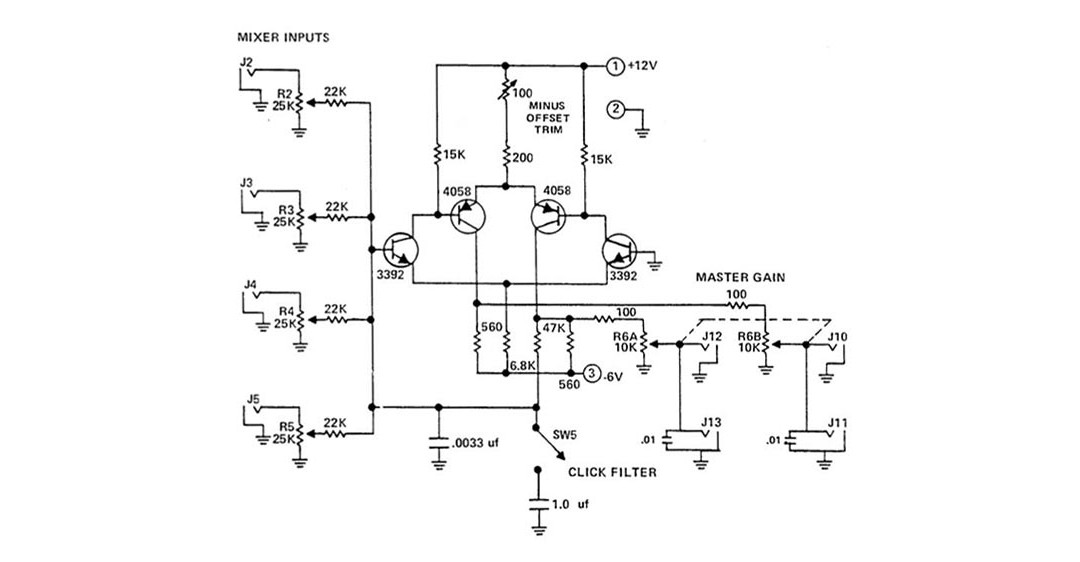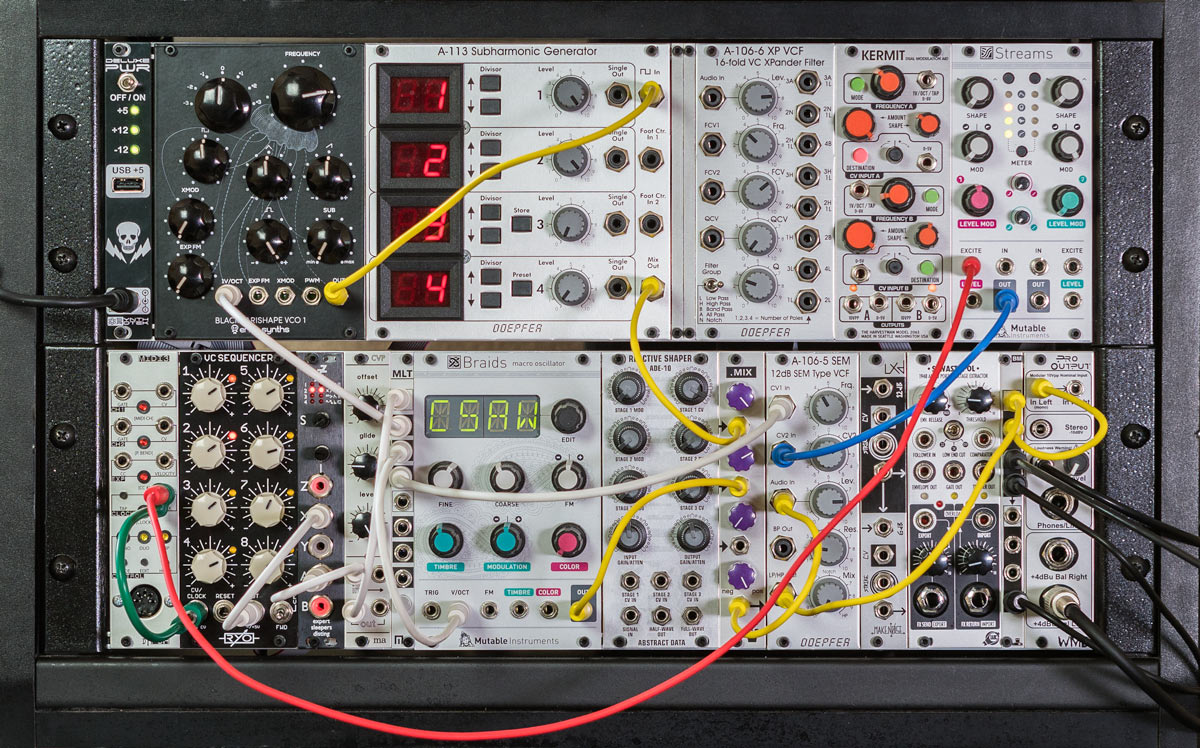Several respected synthesists have spoken in hushed tones about how the Moog CP3 mixer is the “secret sauce” (when added in with the Moog oscillator, VCA, and A Certain Filter) that gives Moog modular systems their huge sound. As a result, some have cloned this otherwise simple circuit in a variety of modular formats.
In this video I spend some time with a Eurorack STG Soundlabs .mix CP3 clone, an oscilloscope with frequency spectrum display, and a few different waveforms to figure out exactly what’s going, with tips on how you can apply its particular overdrive characteristics to your own patches to fatten or fizz up their sound (headphones or speakers with good bass are recommended):
If you don’t have time to watch the video or aren’t in a place where you can listen to it, here’s the summary:
- The + output has more harmonic distortion on it than the – output, adding a second harmonic even when not being overdriven.
- Distortion can start as early as 12:00 on the input dials with a +/–8v oscillator signal. (By the way, the CP3 clips the final signal to +/–6v.)
- When the + output just starts to clip, the peak of the waveform is pulled up to +6v in the shape of a spike, adding high-end fizz to the sound. This is particularly apparent in harmonically pure waveforms such as sine waves.
- With the inputs turned up all the way into deep overdrive, the final waveform is heavily clipped. Sawtooth waves get their fundamental harmonic strengthened, adding bass to their sound. Sine waves take on a trapezoidal shape. Square waves…remain square.
- The CP3 utilizes an old-fashioned “passive” mix bus design, which means there’s crosstalk between the input channels. As a result, turning up one input can appear to reduce the level of the other inputs – the output cannot exceed any one input’s maximum level. At best, this provides auto-leveling of your inputs; at worst, it can yield a sound some have described as phase cancellation.
If you’re trying to reverse-engineer the sequencer patch I used at the end of the video (shown below), here’s some clues:
For these videos and my upcoming course, I color-code my patch cables in the following way:
- yellow = audio signals
- white = 1v/octave pitch control voltages
- blue = other control voltages and modulations
- red = gates & triggers
- green = master sync pulses
As I hinted above, the CP3 does not do much for square waves, but it does wonders for sawtooths. I created a pair of mellow sawtooths (sawteeth?) tuned to octaves using the Doepfer A-113 Subharmonic Generator, and a fizzier sawtooth using the Mutable Instruments Braids VCO set to “CSAW“ (its supposedly CS-80-like waveform) with Timbre set near 12:00.
The cutoff of the Doepfer A-106-5 SEM filter set to low-pass mode (why the SEM? because I wanted to show you could get That Sound even with an un-Moog-like filter) is driven both by the sequencer and a short AD envelope from the MI Streams.
(No, there is no VCA in this patch; with a brisk sequence of eighth notes that never decayed to silence, there was no need for one – the fast filter envelope with a low initial cutoff was enough.)
I used the internal clock of the Pittsburgh MIDI 3 to sync the RYO VC Sequencer, and also to add as a trigger for the MI Streams. The sequencer goes to the Expert Sleepers Disting in quantizer mode, then to a Manhattan Analog CVP to add a touch of glide. That then goes to the Malekko Performance Buffered Mult to drive the two VCOs and the filter cutoff.



A-113 is a subharmonic generator, not a a-133
Thanks for the correction! I fixed it in the article; fortunately I think the voiceover in the video is okay.
Another excellent video. I’m really digging your content on here. Wish I had this resource when starting my eurorack modular setup.
Thank you, Jason! I’m in the middle of editing my Intro to Modular Synths course to help others just starting out. And then I can get back to creating more content for this site, such as a glossary…
excellent article. I was told by someone that the cp3 mixer was an important factor in the sound of the MOOG modular. This article gives some great technical background. Have you ever compared cp3 ‘s from different manufacturers?
Thanks for the feedback. I’ve not had a chance to compare different implementations of the CP3 mixer; the core is going to be the same, but there are differences on the output side it seems. The STG version I have has a control that goes between the + and – outputs; the – output has less harmonic distortion. The Manhattan Analog version has an offset control to induce add a DC offset at the output, should you want to use this to mix control voltages. I just got an AJHSynth Ring Mod SM which has a 5-channel CP-3-like mixer built in, including one channel with extra gain; I’ll be exploring that soon.
Thanks for the post! Been looking for some description on this module for some time. My Mos-Lab System 1P did not come with a manual. Neither can I find any useful resources to learn how to harness its power. Maybe this site would help! Which course would you recommend? You can see a description of my system below. I like the idea of the Arturia course, but I have the 901 oscillators and many less modules than the soft synth.
https://www.mos-lab.com/systems
I agree that the Arturia software will be the closest match for what you have on the Mos-Lab 15; just ignore the movies on modules you don’t have like the multi-mode filter. Also, the Arturia software simulates the Cinch-Jones s-triggers visually, and puts a menu underneath them to select trigger sources; you’ll have to actually patch them on your system.
My original Learning Modular Synthesis course will give you a great overview of East Coast style synthesis – including patching the gates & triggers – but won’t be a 1:1 match for your Mos-Lab.
Nice article! One tiny nit to pick though – the mixer is properly an active mixer and not passive and the controls should not interact.
If you look at the circuit the 47k resistor from the right-hand NPN tranny is providing negative feedback to the input and sets the overall gain. The voltage on the base of the left-hand NPN tranny ought to be pretty close to zero at all times, because the amp will provide sufficient feedback to keep it there. It’s a four-transistor opamp effectively, forming a virtual-earth mixer.
What a clever bit of design!